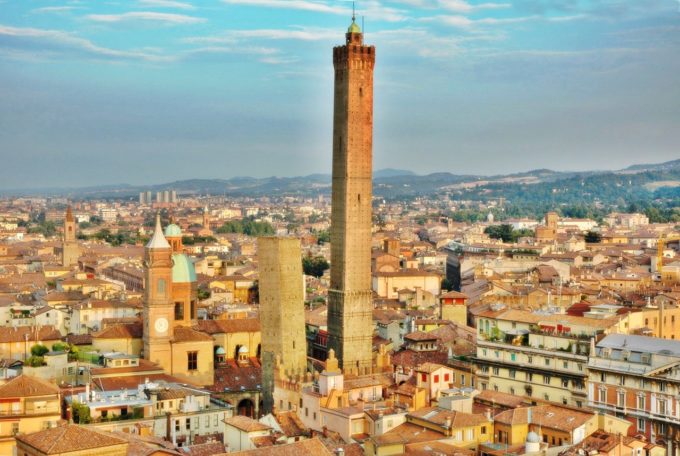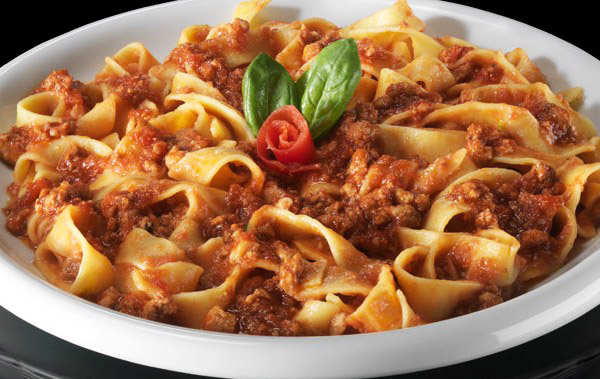Bologna is simply a fabulously rich culinary city located in the Emilia-Romagna region of Italy. It is also home to Pasta Bolognese! This city has the nickname “La Grassa” meaning “the fat,” due to the tremendous amount of culinary delights found in the city.
This is the land of, mortadella, Prosciutto di Parma, Grana Padano, balsamic vinegar, countless numbers of salami and sausages just to name a few of the culinary delights of the area. Let us not forget the endless list of fresh egg pastas. Such as tagliatelle, fettuccine, tortellini, and pappardelle, for starters.
For this post we are concentrating on one sauce, a meat-based sauce that holds the name of the city, yes a Bolognese sauce. Better known in Italy as “Ragù alla Bolognese.” If tomato sauce is the “King” of pasta sauces then Ragù alla Bolognese is most definitely the Queen!
This sauce is served traditionally with broad flat-shaped pasta. But, one pasta, in particular, is considered to be the perfect accompaniment to this sauce. That pasta would be tagliatelle! When talking about Italy, and especially about Italian food, it’s all about regionalism and tradition. Holding true to it is paramount! Especially, among Italian culinary circles in Italy, whose sole purpose is to make sure culinary traditions are followed and stay intact.
To serve this sauce with a dried semolina based pasta would be a big “no-no” and frowned upon by culinary traditionalists in Italy.
So, in “La Grassa” bolognese sauce is held in high esteem as it even carries the name of the city it hails from, Bologna. As one could imagine there is a tremendous amount of pride and heritage connected to this dish and it is taken seriously. I can’t tell you the number of debates I’ve had with other chefs on what is considered to be a true Bolognese.
Some examples of debate are: The kind of meats used, the ratio of each meat, the sofrito (the vegetable mix), the types herbs, the amount of time it should cook, to cover with a lid not cover with a lid, when to season, when to add wine, does one add milk, and should one finish with heavy cream or not?
This my friends is a time-honored sauce and is second in command in pasta land. It is far from just a meat sauce!
So calling a BOLOGNESE a meat sauce simply won’t cut it in traditional culinary circles. Yes, it is made with meat, but there’s much more to it than that, as you’ll see in my recipe below.
Hint: If ever you find yourself in Bologna or the Emila-Romagna region and see a sign in front of a restaurant that says “Spaghetti and meat sauce” in English none the lessor “Spaghetti all Bolognese,” run for the hills. It’s a tourist trap!
Now I share with you the Bolognese sauce the I’ve been making for eons! It is delicious and traditional, with a twist of cinnamon in the recipe.
The cinnamon creates a very subtle, yet tasty undertone. It is an ingredient that should be undetectable by the guests. Meaning, you don’t want people to say, WOW! There is cinnamon in here? You just want them to say WOW! That was the most delicious BOLOGNESE sauce I ever had!
Bolognese Sauce – Ragù alla Bolognese
(Serves : 5-8)
Ingredients:
- Carrots – 2 medium seized (fine diced)
- Butter – 1/2 stick unsalted butter
- Olive Oil – just enough to lightly coat the bottom of the pan along with the melted butter.
- Onions– 2 medium (fine diced)
- Celery– 2 large stalks (fine diced)
- Ground Pork– 1 ¼ lb.
- Ground Beef– 1 ¼ lb.
- Ground Veal – 1 1/4 lbs.
- Milk – 4 cups
- Wine -4 cups white wine
- Tomatoes – 4 cans canned whole tomatoes (juice reserved)
- Salt & Pepper – salt and fresh cracked black pepper to taste.
- Cinnamon – 1knife point to start. I like to keep this very subtle at the start.
Tip: Once the sauce is done and you get to the seasoning phase you can always add more if the cinnamon perfume is not enough. This is an invisible ingredient and should be detectable only by very few people who have excellent palates.
Herbs:
- Bay leaf – 4 leaves
- Sage – 3 leaves chopped fine
- Thyme – 1-1/2 teaspoon fresh, 1teaspoon dry
- Italian flat-leaf parsley – 1-1/2 tablespoons ( fresh, coarsely chopped)
Procedure:
- Combine all the meats along with 2 tablespoons of salt.
- Mix well to make an even distribution of all 3 meets in a mixing bowl
- Heat butter and olive oil in a pot, enough to sauté the vegetables
- Saute lightly with no color, for 5 minutes. Then add the cinnamon and stir through the vegetables until the perfume is released.
- Add the chopped meats to the sauteed vegetables and stir well.
- Cook the meat crumbling and breaking up with wooden spoon over a high flame.
- The meat will start to jive off its juices, cook until mostly all the juices have evaporated and the meat loses its color, but NOT browned. Lower heat to medium.
- Add milk bring back pot back to a simmer, until milk evaporates
- Add wine and bring once again to a simmer until wine COMPLETELY evaporates.
- Add the bay leaves
- Add the crushed tomatoes and their juice, stir in well
- Season with 1 tablespoon salt and 1 tablespoon black pepper.
- Cover with cartouche. (A fancy French word for a parchment paper lid with a hole in the center) Use a normal lid placed slightly off-center to allow steam to be released, if not making the cartouche.
- Simmer gently 2-2 ½ hours
- Stir every 20 minutes scraping up any meat sticking to the bottom of the pot.
To finish: Remove from heat and adjust seasoning.
- This is a crucial stage. The seasoning of this sauce like any sauce especially a meat-based one is an important step. It should not be skipped and be done with full attention to the flavor, tasting, and seasoning to achieve a perfect result.
- At this stage, one can also stir through 1/2 stick of unsalted butter. It makes for a more rich finish. (optional)
- Assess the cinnamon at this stage as well…add with caution and minute amounts if you feel more is needed.
- Remember it is an undertow of flavor, there just to add some perfume and play off the sweetness of the vegetables and meats in a very REFINED way.
- Reserve for service.
- Serve with one of the appropriate pasta mentioned above and top with the Italian parsley and Parmesan cheese.
Buon Appetito!
Savor Life …One Bite… At a Time
For more on Emilia-Romagna click here.



